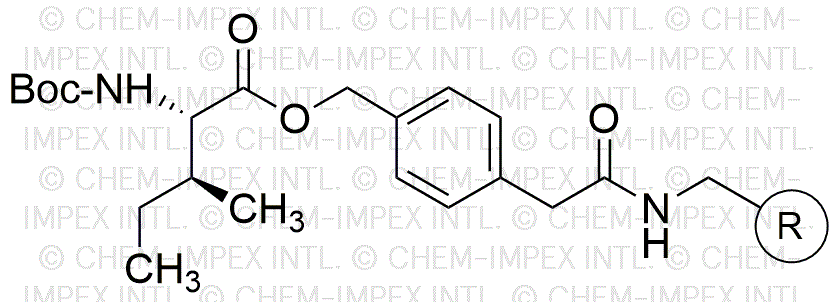Boc-L-isoleucine 4-oxymethylphenylacetamidomethyl is widely utilized in research focused on
- Peptide Synthesis: This compound serves as a valuable building block in the synthesis of peptides, particularly in the development of pharmaceuticals. Its protective Boc group allows for selective reactions, making it easier to construct complex peptide sequences.
- Drug Development: In the pharmaceutical industry, it is used to create drug candidates that target specific biological pathways. Its unique structure can enhance the bioavailability and efficacy of therapeutic agents.
- Bioconjugation: The compound is employed in bioconjugation processes, where it can be linked to other biomolecules for targeted drug delivery systems. This application is crucial in developing more effective cancer therapies.
- Research in Protein Engineering: Researchers utilize this compound to modify proteins, allowing for the study of protein interactions and functions. This is essential in fields such as biotechnology and molecular biology.
- Analytical Chemistry: It is also used as a standard in analytical methods, helping to calibrate instruments and validate results in various chemical analyses.
General Information
Properties
Safety and Regulations
Applications
Boc-L-isoleucine 4-oxymethylphenylacetamidomethyl is widely utilized in research focused on
- Peptide Synthesis: This compound serves as a valuable building block in the synthesis of peptides, particularly in the development of pharmaceuticals. Its protective Boc group allows for selective reactions, making it easier to construct complex peptide sequences.
- Drug Development: In the pharmaceutical industry, it is used to create drug candidates that target specific biological pathways. Its unique structure can enhance the bioavailability and efficacy of therapeutic agents.
- Bioconjugation: The compound is employed in bioconjugation processes, where it can be linked to other biomolecules for targeted drug delivery systems. This application is crucial in developing more effective cancer therapies.
- Research in Protein Engineering: Researchers utilize this compound to modify proteins, allowing for the study of protein interactions and functions. This is essential in fields such as biotechnology and molecular biology.
- Analytical Chemistry: It is also used as a standard in analytical methods, helping to calibrate instruments and validate results in various chemical analyses.
Documents
Safety Data Sheets (SDS)
The SDS provides comprehensive safety information on handling, storage, and disposal of the product.
Product Specification (PS)
The PS provides a comprehensive breakdown of the product’s properties, including chemical composition, physical state, purity, and storage requirements. It also details acceptable quality ranges and the product's intended applications.
Certificates of Analysis (COA)
Search for Certificates of Analysis (COA) by entering the products Lot Number. Lot and Batch Numbers can be found on a product’s label following the words ‘Lot’ or ‘Batch’.
Numéro de catalogue
Numéro de lot/série
Certificates Of Origin (COO)
This COO confirms the country where the product was manufactured, and also details the materials and components used in it and whether it is derived from natural, synthetic, or other specific sources. This certificate may be required for customs, trade, and regulatory compliance.
Numéro de catalogue
Numéro de lot/série
Safety Data Sheets (SDS)
The SDS provides comprehensive safety information on handling, storage, and disposal of the product.
DownloadProduct Specification (PS)
The PS provides a comprehensive breakdown of the product’s properties, including chemical composition, physical state, purity, and storage requirements. It also details acceptable quality ranges and the product's intended applications.
DownloadCertificates of Analysis (COA)
Search for Certificates of Analysis (COA) by entering the products Lot Number. Lot and Batch Numbers can be found on a product’s label following the words ‘Lot’ or ‘Batch’.
Numéro de catalogue
Numéro de lot/série
Certificates Of Origin (COO)
This COO confirms the country where the product was manufactured, and also details the materials and components used in it and whether it is derived from natural, synthetic, or other specific sources. This certificate may be required for customs, trade, and regulatory compliance.

